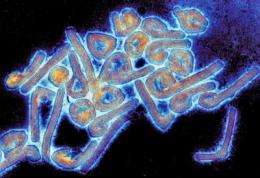Experimental Marburg vaccine prevents disease 2 days after infection

An experimental vaccine developed to prevent outbreaks of Marburg hemorrhagic fever continues to show promise in monkeys as an emergency treatment for accidental exposures to the virus that causes the disease. There is no licensed treatment for Marburg infection, which has a high fatality rate.
In a study of rhesus macaques, 5 of 6 monkeys survived a lethal dose of Marburg virus when treated 24 hours after infection, and 2 of 6 survived when treated 48 hours after infection. Because rhesus macaques typically succumb to Marburg infection faster than humans, the post-exposure treatment window might be extended even further in humans, the study authors say.
The study, overseen by a scientific team from the National Institutes of Health and three other groups with expertise in viral hemorrhagic fevers, was posted online today by the journal Emerging Infectious Diseases.
Marburg and Ebola are the only members of the filovirus family. They are hemorrhagic fever pathogens, meaning the infection may lead to shock, bleeding and multi-organ failure. According to the World Health Organization, Marburg hemorrhagic fever has a fatality rate of up to 80 percent, while Ebola fever has a fatality rate of up to 90 percent. Confirmed cases of these hemorrhagic fevers have been reported in about a half-dozen African nations, according to the Centers for Disease Control and Prevention. Cases of Marburg have occurred outside Africa, though infrequently. Ebola is not known to be native to other continents, such as North America.
"Developing safe, effective, and rapidly deployable post-exposure treatments for filoviruses is an important scientific priority for our Institute," says Anthony S. Fauci, M.D., director of NIH's National Institute of Allergy and Infectious Diseases (NIAID). "The vaccine used in this study is among several novel approaches to treating filoviruses that show great potential."
In the study, the scientists sought to answer a question that lingered from research they published in 2006: How long after a usually lethal Marburg virus dose could the experimental vaccine be administered and still provide protection? The 2006 study, also conducted in rhesus macaques, showed 100 percent protection, but the vaccine was given within 30 minutes of lethal exposure.
The timing question is particularly relevant for scientists who study this virus under strict biosafety laboratory guidelines. One such scientist is Heinz Feldmann, M.D., Ph.D., chief of the Laboratory of Virology at NIAID's Rocky Mountain Laboratories in Hamilton, Mont. Dr. Feldmann and his colleagues developed the candidate Marburg vaccine while working for the Public Health Agency of Canada. Collaborators on the current study came from that agency, Boston University and the U.S. Army Medical Research Institute of Infectious Diseases, where most of the animal work was done in 2008-09.
The experimental Marburg vaccine is based on a weakened vesicular stomatitis virus (VSV) used to carry and display a component of the Marburg virus. VSV is an infectious disease of horses, cattle and pigs. Dr. Feldmann and his colleagues also have developed a similar experimental VSV-based vaccine against Ebola. Both vaccines are recognized by the same immune cells in the body as Ebola and Marburg viruses, activating the immune system to fight off the target virus.
The fact that three of the rhesus macaques in the current study showed evidence of Marburg virus in periodic blood tests, but later cleared the virus from their systems and survived, is particularly satisfying to Dr. Feldmann and his main collaborator, Tom Geisbert, Ph.D., of Boston University. In addition, 14 days after infection, all of the rhesus macaques that survived showed moderate to high levels of antibodies against Marburg virus. The scientists view this as proof that the vaccine worked as hoped.
"The results demonstrate that the vaccine can interfere with the Marburg infection and activate the immune system, both protecting the animals and preventing the virus from spreading," says Dr. Feldmann. Dr. Geisbert believes the study data justify rapid development of VSV-based vaccines for the treatment of filovirus-infected patients either in outbreaks or accidental laboratory exposures.
In 2009, Drs. Feldmann and Geisbert were part of an international group of experts that recommended using the same post-exposure treatment strategy for the first time in a human. A researcher who accidentally was stuck with an Ebola-contaminated needle voluntarily received the experimental VSV Ebola vaccine 40 hours after the exposure. The researcher, who never showed signs of infection, survived. The scientists have not yet found a way to determine whether an Ebola infection occurred in this case, however, and whether the vaccine played a role in the outcome.
More information: References:
T Geisbert et al. Postexposure treatment of Marburg virus infection. Emerging Infectious Diseases. DOI:10.3201/eid1607.100159 (2010).
K Daddario-DiCaprio et al. Postexposure protection against Marburg haemorrhagic fever with recombinant vesicular stomatitis virus vectors in non-human primates: an efficacy assessment. Lancet. DOI:10.1016/S0140-6736(06)68546-2 (2006).
H Feldmann et al. Effective post-exposure treatment of Ebola infection. PLOS Pathogens. DOI:10.1371/journal.ppat.0030002 (2007).















